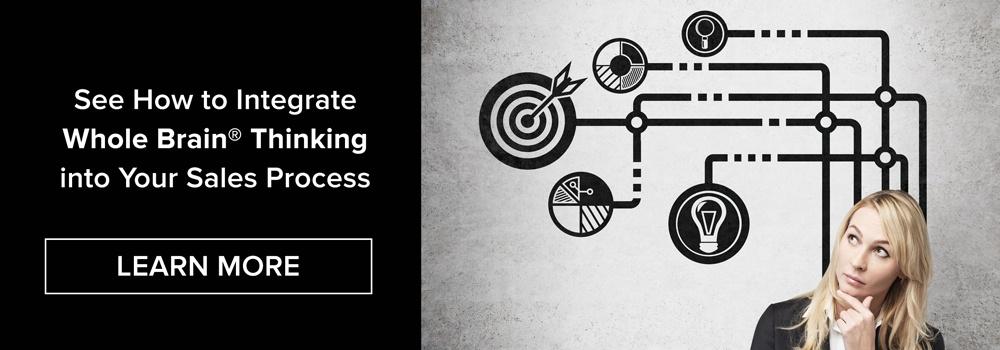Whether you’re talking about a product or service, pitching an idea, making the case for budget allocations, or trying to convince someone to get on board with a new strategy, selling is a part of the job description for most of us in one way or another. As Dan Pink put it, To Sell is Human.
But just because it’s human to sell, that doesn’t mean we all do it well. Selling effectively requires understanding the person on the other side of that pitch. What do they care about? What really matters to them?
Wouldn’t it be great if you had a special power that allowed you to get inside their head?
The Force is With You
Star Wars characters have the Force. Here on earth, you have access to a power that can help you maximize your effectiveness in any situation: the brain. Whole Brain® Thinking—the ability to understand, adapt and apply your thinking to get the best results—is always available to you. You just have to be intentional about using it.
Selling is a perfect example of how Whole Brain® Thinking not only enhances what you may already be doing, but also brings simplicity and clarity to an often-complex task. Let’s take a closer look at why it’s so effective in maximizing sales effectiveness.
4 Benefits of a Thinking-Based Approach to Sales
The buying decision is directly related to the way people think. Their behavior may change or be affected by external factors, but thinking is constant. As one learning and development leader recently shared, in explaining why her company uses a thinking-based approach, “You may be putting on a personality for work but it’s not really who you are. How you think is how you think. That doesn’t change.”
And how you think affects everything else.
The Whole Brain® Model provides a quick and simple way to get inside the head of a prospect, manager, investor, team member or anyone else and understand their mental processes—how they go about making a decision, what they pay attention to and what influences them the most.
No matter what kind of selling situation you’re in, this gives you four advantages:
- Information. To truly understand people, you can't just look at behaviors for clues. Our complex world doesn't allow us to get away with that. It's just not enough information. The Whole Brain® Model reveals the thinking “engine” behind any buying decision and puts observable behaviors into an actionable context.
- Authenticity. The model doesn't impose a new sales system or values on you. Instead, it enriches your existing approach by helping you understand how and why people decide to buy. You don't have to throw away your current selling methods or change who you are. Just build on your current anchor points with a Whole Brain® approach.
- Solutions. You can also use the Whole Brain® Model or, even better, a validated assessment like the Herrmann Brain Dominance Instrument® (HBDI®) to understand your own thinking process and diagnose any challenges that you encounter during the sales cycle or persuasion process. The resulting clarity can help you (and your manager) drill down to problems and solve them.
- Speed. When buyer and seller align at the deep level of thinking, they accelerate the process. Bottom line: using thinking as your foundation makes the buying decision easier and faster for everyone involved.
Tips for Selling to Different Thinkers
Because you have access to your entire brain, not just the modes you prefer the most, you have the power to adapt your thinking to the preferences of your buyers.
Below are some tips for optimizing your approach with different thinkers, keeping in mind that most of us have preferences for more than one quadrant.
In sales terms, an easy way to look at the different kinds of thinkers you might encounter is with the acronym REPS—each letter corresponds with one of the four quadrants of the Whole Brain® Model:
Sign up to our newsletter for the latest insights
- When talking to people with strong preferences in this quadrant, be sure to back up your claims with evidence.
Execution. The lower-left green quadrant is all about how to achieve desired results. People with this preference place a high value on follow-through. They move into action and make sure that tasks get done. In addition, they like to follow step-by step processes—to “cross the t’s and dot the I’s.”
- When talking to people with strong preferences in this quadrant, move through the sales process in a clear and consistent way. Otherwise you can instantly lose credibility.
People. The lower-right red quadrant represents “people first” thinking. Buyers with this preference want to know how a decision will affect the people they care about—coworkers, friends, family members. They also look for a “gut” feeling that you're the right person to work with because you see the world from their viewpoint.
- When talking to people with strong preferences in this quadrant, practice deep and authentic listening. Use your intuition to go beyond the obvious questions, and engage in a natural way. You'll know you’re succeeding when the person opens up and shares what they feel as well as what they think.
Strategy. The yellow quadrant in the upper right represents the ability to see context—the “big picture.” People with strong preferences here can think creatively about their goals and ways to achieve them. In addition, they can frame problems in new ways and combine ideas to come up with novel solutions.
- Before you talk to buyers with strong preferences in this quadrant, take the time to learn about the challenges they face and the specific problems they want to solve. During meetings think flexibly, respond with agility, and be willing to put your agenda on hold and take the conversation down a new path.
You don’t need supernatural powers to maximize your sales effectiveness. Buying is about thinking. Use the Whole Brain® Model to get inside the buyer’s head, and then leverage the power of Whole Brain® Thinking to adapt to their preferences.
The results will be out of this world.













